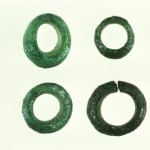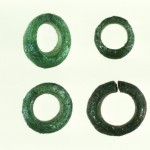As Digital Asset Specialist at the Museum, I have the pleasure of working with our Research Scientist Emeritus, Dr. Bob Brill, as he digitizes some of the materials in his personal archive. Dr. Brill’s history with the Museum stretches back almost 40 years, and he has traveled all over the world for his work conducting chemical analyses and other scientific investigations of ancient glass. It should come as no surprise, then, that he has shared some incredible materials and stories with me.
- Glass Beads (Bib. no. 127878)
- Glass Beads (Bib. no. 127878)
One such gem is this slide (bib no. 127878). At first glance, it may not look like much – four green glass circles. These aren’t just any pieces of glass, however. These are four green glass beads excavated from San Salvador Island, the Bahamas, from the site of Christopher Columbus’s first landfall in the New World.
Christopher Columbus’s journal entry from October 12, 1492, records that land was (finally) spotted on the horizon at sunrise. This land is now believed to be San Salvador Island. Columbus’s ships sailed around the island later that day, and Columbus noted that local inhabitants rode out in boats to greet them. The European sailors traded small trinkets with them, he wrote, including small glass beads, shoe buckles, snippets of coins, and bits of broken crockery. While these items had little value to the Europeans, to the native inhabitants of the Bahamas, who lacked glassmaking technology and metallurgy, such things would have been remarkable.
Almost 500 years later, in the 1970s, an excavation was underway at San Salvador Island. At the place traditionally held to be Columbus’s landing site, archaeologists uncovered small glass beads, including the ones shown in Dr. Brill’s slide; coinage that was later dated to 1472; and shoebuckles. The lead in the glass beads was shown to have come from Spain.
Although four green glass circles don’t seem impressive at first glance, these beads actually have incredible historical significance – they were likely among the first items ever traded between residents of the New World and the Old. And they’re also a reminder to never judge an image (or a slide!) by your first impression.



3 comments » Write a comment